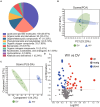Differential effects of domesticated and wild Capsicum frutescens L. on microbial community assembly and metabolic functions in rhizosphere soil
- PMID: 39040904
- PMCID: PMC11261347
- DOI: 10.3389/fmicb.2024.1383526
Differential effects of domesticated and wild Capsicum frutescens L. on microbial community assembly and metabolic functions in rhizosphere soil
Abstract
Objective: Rhizosphere microorganisms play crucial roles in the growth and development of plants, disease resistance, and environmental adaptability. As the only wild pepper variety resource in China, domesticated Capsicum frutescens Linn. (Xiaomila) exhibits varying beneficial traits and affects rhizosphere microbial composition compared with its wild counterparts. In this study, we aimed to identify specific rhizosphere microbiome and metabolism patterns established during the domestication process.
Methods: The rhizosphere microbial diversity and composition of domesticated and wild C. frutescens were detected and analyzed by metagenomics. Non-targeted metabolomics were used to explore the differences of metabolites in rhizosphere soil between wild and domesticated C. frutescens.
Results: We found that the rhizosphere microbial diversity of domesticated variety was significantly different from that of the wild variety, with Massilia being its dominant bacteria. However, the abundance of certain beneficial microbes such as Gemmatimonas, Streptomyces, Rambibacter, and Lysobacter decreased significantly. The main metabolites identified in the wild variety included serylthreonine, deoxyloganic acid, vitamin C, among others. In contrast, those identified in the domesticated group were 4-hydroxy-l-glutamic acid and benzoic acid. Furthermore, the differentially enriched pathways were concentrated in tyrosine and tryptophan biosynthesis, histidine and purine-derived alkaloids biosynthesis, benzoic acid family, two-component system, etc.
Conclusion: This study revealed that C. frutescens established specific rhizosphere microbiota and metabolites during domestication, which has important significance for the efficient utilization of beneficial microorganisms in breeding and cultivation practices.
Keywords: Capsicum frutescens L.; Massilia; metabolome; metagenome; rhizosphere soil.
Copyright © 2024 Wang, Zhang, Wang, Lv, Xu, Zhang, Yang, Meng and Xu.
Conflict of interest statement
The authors declare that the research was conducted in the absence of any commercial or financial relationships that could be construed as a potential conflict of interest.
Figures







Similar articles
-
Changes in Rhizosphere Soil Microorganisms and Metabolites during the Cultivation of Fritillaria cirrhosa.Biology (Basel). 2024 May 11;13(5):334. doi: 10.3390/biology13050334. Biology (Basel). 2024. PMID: 38785816 Free PMC article.
-
Multiomics Reveals the Effect of Root Rot on Polygonati Rhizome and Identifies Pathogens and Biocontrol Strain.Microbiol Spectr. 2022 Apr 27;10(2):e0238521. doi: 10.1128/spectrum.02385-21. Epub 2022 Feb 28. Microbiol Spectr. 2022. PMID: 35225655 Free PMC article.
-
Changes in enzyme activity and microbial community of rhizosphere soil under continuously monocultured Passiflora edulis treatment.PLoS One. 2025 Jul 16;20(7):e0328363. doi: 10.1371/journal.pone.0328363. eCollection 2025. PLoS One. 2025. PMID: 40668837 Free PMC article.
-
Home treatment for mental health problems: a systematic review.Health Technol Assess. 2001;5(15):1-139. doi: 10.3310/hta5150. Health Technol Assess. 2001. PMID: 11532236
-
Behavioral interventions to reduce risk for sexual transmission of HIV among men who have sex with men.Cochrane Database Syst Rev. 2008 Jul 16;(3):CD001230. doi: 10.1002/14651858.CD001230.pub2. Cochrane Database Syst Rev. 2008. PMID: 18646068
References
-
- Abdullaeva Y., Ratering S., Manirajan B. A., Rosado-Porto D., Schnell S., Cardinale M. (2022). Domestication impacts the wheat-associated microbiota and the rhizosphere colonization by seed- and soil-originated microbiomes, across different fields. Front. Plant Sci. 12:806915. doi: 10.3389/fpls.2021.806915, PMID: - DOI - PMC - PubMed
-
- Banerjee S., Kirkby C. A., Schmutter D., Bissett A., Kirkegaard J. A., Richardson A. E. (2016b). Network analysis reveals functional redundancy and keystone taxa amongst bacterial and fungal communities during organic matter decomposition in an arable soil. Soil Biol. Biochem. 97, 188–198. doi: 10.1016/j.soilbio.2016.03.017 - DOI
LinkOut - more resources
Full Text Sources
Research Materials

